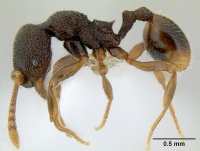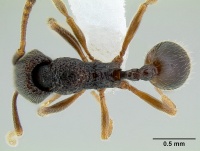Stenamma cusuco
| Stenamma cusuco | |
|---|---|
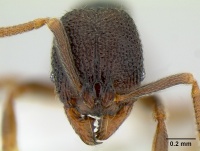
| |
| Scientific classification | |
| Kingdom: | Animalia |
| Phylum: | Arthropoda |
| Class: | Insecta |
| Order: | Hymenoptera |
| Family: | Formicidae |
| Subfamily: | Myrmicinae |
| Tribe: | Stenammini |
| Genus: | Stenamma |
| Species: | S. cusuco |
| Binomial name | |
| Stenamma cusuco Branstetter, 2013 | |
This species has been collected from only a few samples of sifted leaf litter from the forest floor. It inhabits montane wet forest from approximately 1200–1400 m elevation. The shape of the anterior margin of the clypeus is unique among Stenamma species. Most peculiar is the strongly projecting median lobe, which forms a toothlike protuberance. This trait probably correlates with diet specialization, but nothing is known yet about prey choice in this species.
Identification
Branstetter (2013) - Integument mostly red-black; small- to medium-sized species (see HL, ML, and PrW below); anterior clypeal margin in full-face view, with three projecting teeth, two well-defined sharp outer teeth, and a blunt central tooth, formed by a projecting median clypeal lobe; anterior clypeal margin underneath median clypeal lobe with two blunt teeth; basal margin of mandible sinuous, with a distinct basal depression, but no basal tooth; frontal lobes markedly expanded (FLD 0.19–0.22, FLI 24–26), completely obscuring the torular lobes in full-face view; eye of moderate size (EL 0.09–0.11, REL 14–17), with 5–6 ommatidia at greatest diameter; propodeal spines present and of moderate length (PSL 0.16–0.19, PSI 1.8–2.2); gastral setae short, and clearly bilayered, with a layer of suberect setae, and a layer of slightly shorter but denser subdecumbent setae. Similar species: Stenamma catracho, Stenamma hojarasca, Stenamma ochrocnemis.
The structure of the clypeus is unique among known Stenamma species. Thus, S. cusuco should not be confused with any other species.
Keys including this Species
Distribution
Only known from the area where the types were collected - Parque Nacional Cusuco, Cortés, Honduras.
Latitudinal Distribution Pattern
Latitudinal Range: 15.49037° to 15.4881761°.
| North Temperate |
North Subtropical |
Tropical | South Subtropical |
South Temperate |
- Source: AntMaps
Distribution based on Regional Taxon Lists
Neotropical Region: Honduras (type locality).
Distribution based on AntMaps
Distribution based on AntWeb specimens
Check data from AntWeb
Countries Occupied
| Number of countries occupied by this species based on AntWiki Regional Taxon Lists. In general, fewer countries occupied indicates a narrower range, while more countries indicates a more widespread species. |

|
Estimated Abundance
| Relative abundance based on number of AntMaps records per species (this species within the purple bar). Fewer records (to the left) indicates a less abundant/encountered species while more records (to the right) indicates more abundant/encountered species. |

|
Biology
Castes
Males have yet to be collected.
Worker
Images from AntWeb
 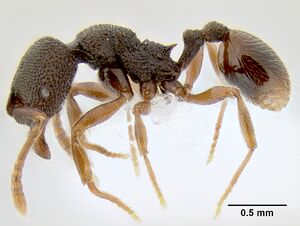  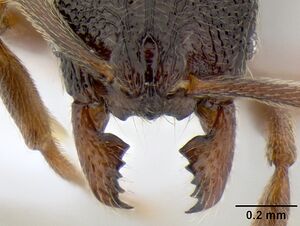 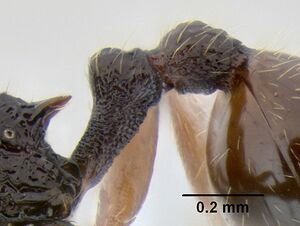 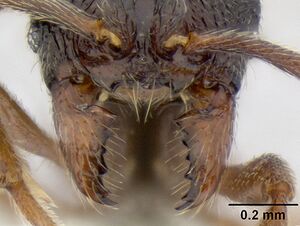  
| |
| Holotype Stenamma cusuco. Worker. Specimen code casent0622137. Photographer Michael Branstetter, uploaded by Default Group. | Owned by USNM. |
Queen
Images from AntWeb
   
| |
| Paratype Stenamma cusuco. Queen (alate/dealate). Specimen code casent0622136. Photographer Michael Branstetter, uploaded by Default Group. | Owned by USNM. |
Nomenclature
The following information is derived from Barry Bolton's Online Catalogue of the Ants of the World.
- cusuco. Stenamma cusuco Branstetter, 2013: 87, figs. 72, 73 (w.q.) HONDURAS.
- Type-material: holotype worker, 14 paratype workers, 2 paratype queens.
- Type-locality: holotype Honduras: Cortés, Parque Nac. Cusuco, 15.48965°N, 88.23383°W±35m., 1300 m., 31.v.2010, LLAMA Wm-C-06-1-04; paratypes: 9 workers, 2 queens with same data, 3 workers with same data but 15.48940°N, 88.23598°W±20m., 1290 m., 30.v.2010, LLAMA Wa-C-06-2-07, 2 workers with same data but 15.49037°N, 88.23402°W±40m., 1330 m., 31.v.2010, LLAMA Wm-C-06-1-07.
- Type-depositories: USNM (holotype); CASC, CFSS, EAPZ, FMNH, INBC, JTLC, LACM, MCZC, MGBC, MZSP, UCDC, UNAM, USNM, UVGC (paratypes).
- Distribution: Honduras.
Unless otherwise noted the text for the remainder of this section is reported from the publication that includes the original description.
Description
Worker
(5 measured) HL 0.74–0.80 (0.78), HW 0.63–0.69 (0.66), FLD 0.24–0.26 (0.26), PCW 0.02–0.03 (0.03), SL 0.54 –0.59 (0.59), EL 0.09–0.11 (0.10), ACL 0.54–0.57 (0.57), ML 0.88–0.97 (0.94), PrW 0.45–0.49 (0.48), PSL 0.16–0.19 (0.18), SDL 0.08–0.10 (0.09), PL 0.34–0.37 (0.37), PH 0.18–0.20 (0.20), PW 0.14–0.16 (0.16), PPL 0.18–0.20 (0.20), PPH 0.16–0.19 (0.19), PPW 0.19– 0.20 (0.20), MFL 0.60–0.64 (0.63), MTL 0.50–0.52 (0.51), CI 83–87 (86), SI 84–89 (89), REL 14–17 (15), FLI 36–39 (39), PSI 1.8–2.2 (2.1), MFI 104–111 (106), ACI1 66–68 (67), ACI2 96–100 (96).
Small- to medium-sized species; general body color red black, with patches of brown on gaster; mandibles and appendages lighter, mostly brown to orange-brown; setae pale golden brown; mandible usually with 6 teeth, sometimes with 1–2 small denticles, basal tooth well-defined; basal margin of mandible sinuous, with a distinct basal depression, but no basal tooth; mandible mostly smooth and shiny, with scattered piligerous punctae and basal striae; anterior clypeal margin in full-face view, with three projecting teeth, two well-defined outer teeth, and a more blunt central tooth, formed from a projecting median clypeal lobe; anterior clypeal margin underneath median clypeal lobe with two blunt teeth (only visible with mandibles open and from an anterodorsal view); median clypeal lobe surface usually with a single median longitudinal carinula and a variable number of irregular foveolae, remainder of clypeus smooth and shiny; posterior extension of clypeus between antennal insertions hour-glass-shaped, with middle of hourglass narrow (PCW 0.02–0.03); frontal lobes noticeably expanded (FLD 0.19–0.22, FLI 24–26), completely obscuring the torular lobes in full-face view; head roughly oval-shaped (CI 83–87), posterior margin with a slight median depression; eye of moderate size (EL 0.09–0.11, REL 14–17), oval-shaped, with 5–6 ommatidia at greatest diameter; head strongly rugoreticulate (not quite foveate), with a few short costae extending back from the frontal lobes and posterior clypeal extension; scape somewhat short (SI 84–89), not reaching posterior margin of head when laid back; scape surface shiny, but somewhat rough, with scattered piligerous punctae, punctulae, and fine striae; flagellum with a somewhat distinct 4-segmented antennal club; mesosoma mostly strongly rugose to rugoreticulate, with finer reticulae, becoming punctae, on pronotal side and anepisternum, rugae near anterior margin of pronotal dorsum usually with a transverse orientation; propodeal dorsum and declivity with transverse carinulae; promesonotum in profile low-domed and roughly symmetrical, but anterior declivity somewhat shorter and steeper; metantoal grove well- demarcated, of moderate width and depth; anterodorsal margin of propodeum with a small welt; propodeal spines present and of moderate length (PSL 0.16–0.19, PSI 1.8–2.2); petiole appearing of moderate length (PL/HW 0.52–0.55); petiolar node relatively small (PH/PL 0.53–0.56), domed, but slightly asymmetrical in profile, with the anterior face longer and more sloping than posterior face; postpetiole subspherical, without a prominent dorsal node; anterior faces of petiolar and postpetiolar nodes smooth and shiny, anterior and lateral sides with a variable number of rugulae and faint punctae; ventral surfaces of waist segments punctate; most of body dorsum with short standing pilosity; setae on scape mostly subdecumbent; gastral setae short, and clearly bilayered, with a layer of suberect setae, and a layer of slightly shorter but denser subdecumbent setae; setae on legs mostly appressed with some suberect setae on coxae and femoral venters.
Queen
(1 measured) HL 0.78, HW 0.71, FLD 0.26, PCW 0.04, SL 0.59, EL 0.17, ACL 0.57, ML 1.10, PrW 0.63, PSL 0.21, SDL 0.12, PL 0.41, PH 0.22, PW 0.18, PPL 0.22, PPH 0.21, PPW 0.18, MFL 0.66, MTL 0.55, CI 90, SI 84, REL 24, FLI 37, PSI 1.8, MFI 107, ACI1 66, ACI2 97.
Same as worker except for standard queen modifications and as follows: pronotum with transverse rugae/rugoreticulae; mesoscutum more rugose than rugoreticulate, with rugae longitudinal in orientation; scutellum with a central patch of smooth cuticle surrounded by longitudinal rugae; mesopleuron partly smooth and shiny.
Type Material
Holotype worker. HONDURAS, Cortés: Parque Nacional Cusuco, 15.48965°N, 88.23383°W ±35m, 1300m, 31 May 2010, mesophyll forest, ex sifted leaf litter (LLAMA, collection Wm-C-06-1-04) USNM, specimen CASENT0622137. Paratypes: same data as holotype 1w, CASC, CASENT0623296, 1w, EAPZ, CASENT0623297, 1w, ECOSCE, CASENT0623298, 1w, FMNH, CASENT0623299, 1w, INBC, CASENT0623300, 1w, LACM, CASENT0623301, 1dq, 1w, MCZ, CASENT0623295, CASENT0623302, 1w, MZSP, CASENT0623303, 1dq, 1w, USNM, CASENT0622136, CASENT0622138; same data but 15.48940°N, 88.23598°W ±20m, 1290m, 30 May 2010 (LLAMA, Wa-C-06-2-07) 1w, UCDC, CASENT0621743, 1w, UNAM, CASENT0621741, 1w, UVGC, CASENT0621742; 15.49037°N, 88.23402°W ±40m, 1330m, 31 May 2010 (LLAMA, Wm-C-06-1-07) 1w, JTLC, CASENT0623538, 1w, MGBPC, CASENT0623539].
Etymology
The specific epithet cusuco refers to the type locality at Parque Nacional Cusuco in Honduras.
References
- Branstetter, M. G. 2012. Origin and diversification of the cryptic ant genus Stenamma Westwood (Hymenoptera: Formicidae), inferred from multilocus molecular data, biogeography and natural history. Systematic Entomology 37:478-496. doi:10.1111/j.1365-3113.2012.00624.x.
- Branstetter, M.G. 2013. Revision of the Middle American clade of the ant genus Stenamma Westwood (Hymenoptera, Formicidae, Myrmicinae). ZooKeys 295, 1–277. doi:10.3897/zookeys.295.4905
References based on Global Ant Biodiversity Informatics
- Longino J. T. L., and M. G. Branstetter. 2018. The truncated bell: an enigmatic but pervasive elevational diversity pattern in Middle American ants. Ecography 41: 1-12.
